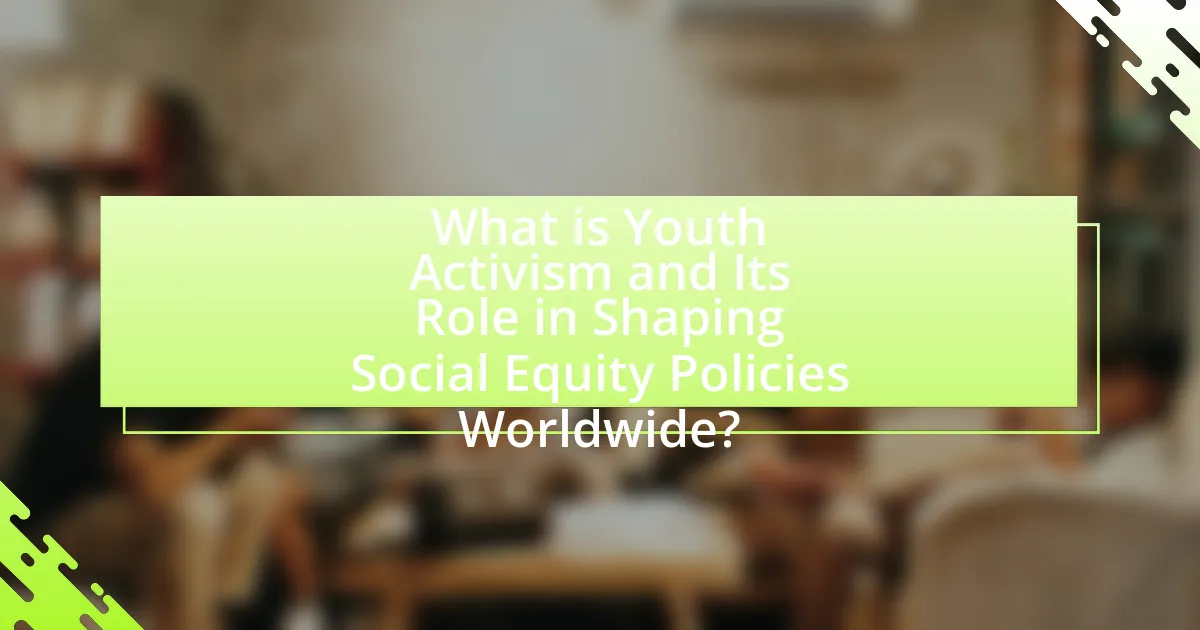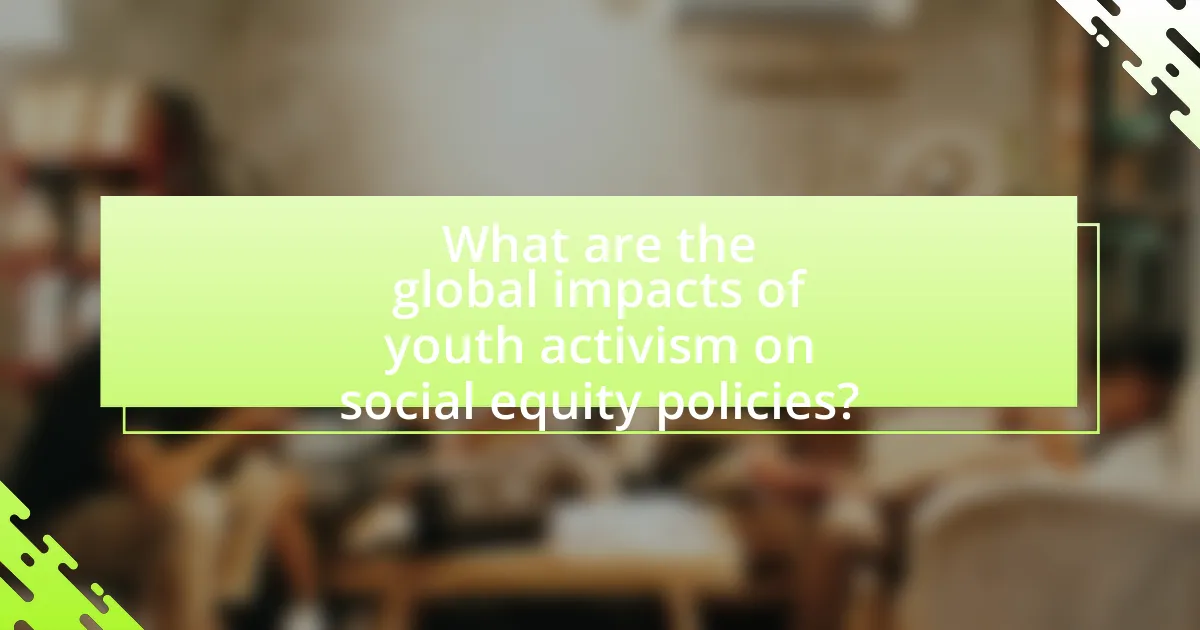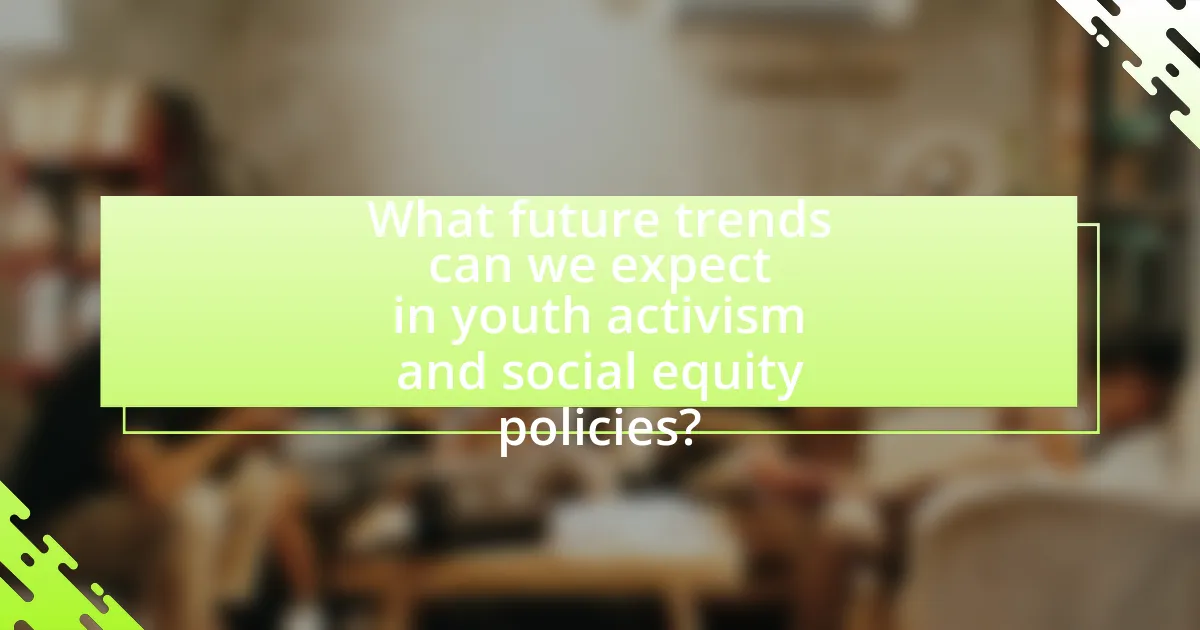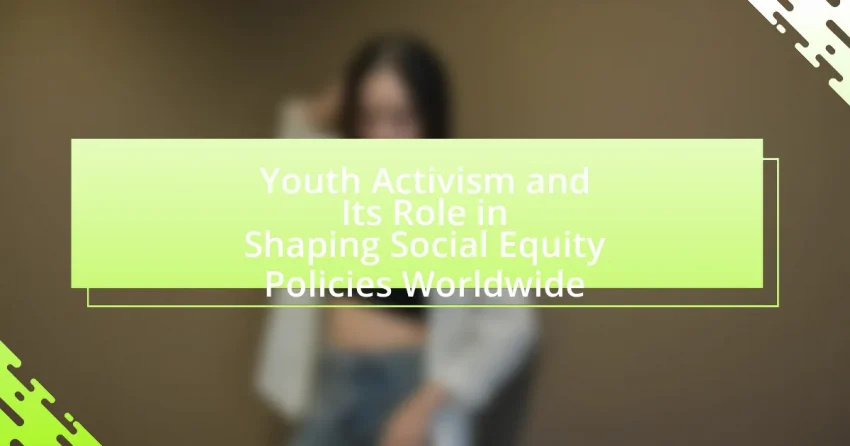Youth activism refers to the engagement of young individuals in advocating for social change and justice, significantly impacting social equity policies worldwide. This article explores the evolution of youth activism, highlighting its historical influences, key issues such as climate change and racial justice, and the role of digital platforms in mobilization. It examines the challenges faced by young activists, the importance of intersectionality, and the ways in which youth-led movements have successfully driven policy reforms. Additionally, the article discusses the support available for youth activism, the role of educational institutions, and future trends in activism and social equity policies.

What is Youth Activism and Its Role in Shaping Social Equity Policies Worldwide?
Youth activism is the engagement of young people in advocating for social change and justice, significantly influencing social equity policies globally. This activism manifests through organized movements, protests, and campaigns that address issues such as climate change, racial justice, and education reform. For instance, the global climate strikes initiated by youth activists like Greta Thunberg have mobilized millions and pressured governments to adopt more equitable environmental policies. Research indicates that youth-led movements have been pivotal in shaping public discourse and policy decisions, as seen in the increased attention to systemic inequalities following the Black Lives Matter protests. These examples illustrate how youth activism not only raises awareness but also drives legislative changes aimed at promoting social equity.
How has youth activism evolved over the years?
Youth activism has evolved significantly over the years, transitioning from localized movements to global campaigns facilitated by digital platforms. Historically, youth activism in the 1960s and 1970s focused on civil rights and anti-war protests, exemplified by the Vietnam War protests where young people mobilized for social change. In the 1990s, the rise of the internet allowed for broader communication and organization, leading to movements like the anti-globalization protests.
In recent years, youth activism has increasingly centered around issues such as climate change, gun control, and racial justice, with figures like Greta Thunberg and the March for Our Lives movement gaining international attention. The use of social media has amplified youth voices, enabling rapid mobilization and global solidarity, as seen in movements like Black Lives Matter. This evolution reflects a shift towards intersectionality and inclusivity, as young activists address multiple social justice issues simultaneously.
What historical events have influenced youth activism?
Historical events that have influenced youth activism include the Civil Rights Movement of the 1960s, the Vietnam War protests, and the global climate strikes initiated by youth activists like Greta Thunberg. The Civil Rights Movement mobilized young people to advocate for racial equality and social justice, exemplified by the involvement of students in sit-ins and marches, such as the Greensboro sit-ins in 1960. The Vietnam War protests saw significant youth engagement, particularly on college campuses, where students organized demonstrations against U.S. military involvement, highlighting their role in shaping public opinion and policy. Additionally, the climate strikes, which began in 2018, have galvanized millions of young people worldwide to demand urgent action on climate change, showcasing the power of youth-led movements in addressing global issues. These events collectively demonstrate how youth activism has been a catalyst for social change and policy reform.
How do cultural differences impact youth activism globally?
Cultural differences significantly impact youth activism globally by shaping the values, priorities, and methods of engagement among young activists. For instance, in collectivist cultures, youth activism often emphasizes community-oriented goals and collaboration, as seen in movements like the Indigenous rights activism in Canada, where community consensus is vital. Conversely, in individualistic cultures, such as the United States, youth activism may focus on personal expression and individual rights, exemplified by movements like Black Lives Matter, which highlights personal narratives and individual experiences of injustice. These cultural frameworks influence not only the issues prioritized by youth but also the strategies employed, such as peaceful protests in some regions versus more confrontational tactics in others. Research by the United Nations Educational, Scientific and Cultural Organization (UNESCO) indicates that cultural context can dictate the effectiveness of activism, with youth in different regions responding to local socio-political climates and historical legacies.
Why is youth activism important for social equity?
Youth activism is crucial for social equity because it empowers young individuals to advocate for their rights and the rights of marginalized communities. This engagement fosters awareness and drives systemic change, as evidenced by movements like the March for Our Lives, which mobilized youth to address gun violence and advocate for policy reforms. Research indicates that youth-led initiatives can significantly influence public opinion and policy decisions, highlighting their role in shaping equitable social frameworks.
What are the key issues that youth activists focus on?
Youth activists focus on key issues such as climate change, social justice, education reform, and mental health. These issues are critical as they directly impact the future of society and the well-being of younger generations. For instance, climate change is a pressing concern, with youth-led movements like Fridays for Future highlighting the urgency of environmental action. Social justice encompasses racial equality and LGBTQ+ rights, with activists advocating for systemic changes to combat discrimination. Education reform is pursued to ensure equitable access to quality education, while mental health awareness is increasingly prioritized, addressing the rising rates of mental health issues among youth.
How does youth activism contribute to policy changes?
Youth activism contributes to policy changes by mobilizing young people to advocate for social issues, influencing public opinion, and pressuring policymakers. For instance, the global climate strikes initiated by youth activists like Greta Thunberg have led to increased awareness and legislative discussions on climate policies in various countries. Research from the Pew Research Center indicates that youth-led movements significantly impact political engagement and policy reform, as seen in the advocacy for gun control following the Parkland shooting in the United States, which resulted in several states enacting stricter gun laws.
What challenges do youth activists face in their efforts?
Youth activists face significant challenges in their efforts, including lack of funding, limited access to decision-making platforms, and systemic resistance from established institutions. These obstacles hinder their ability to implement change effectively. For instance, a report by the United Nations indicates that youth-led initiatives often struggle to secure financial resources, with only 1% of global philanthropic funding directed towards youth organizations. Additionally, many young activists encounter barriers when trying to engage with policymakers, as traditional political structures frequently overlook their voices. This systemic resistance is evident in various countries where youth movements have been met with pushback from authorities, limiting their impact on social equity policies.
How do political environments affect youth activism?
Political environments significantly influence youth activism by shaping the opportunities and constraints that young people face in mobilizing for social change. In democratic settings, youth often experience greater freedom of expression and access to platforms for advocacy, which can lead to increased participation in movements, as seen in the global climate strikes initiated by youth activists like Greta Thunberg. Conversely, in authoritarian regimes, youth activism may be stifled through censorship, repression, and limited civic space, as evidenced by the suppression of protests in countries like Belarus and Iran. These contrasting political contexts directly impact the strategies, effectiveness, and visibility of youth-led initiatives, ultimately determining their ability to influence social equity policies.
What role does social media play in youth activism?
Social media serves as a crucial platform for youth activism by facilitating communication, mobilization, and awareness around social issues. It enables young activists to share information rapidly, organize events, and connect with like-minded individuals globally. For instance, movements like #BlackLivesMatter and #FridaysForFuture gained momentum through social media, demonstrating its effectiveness in raising awareness and driving participation. According to a 2020 study published in the Journal of Youth Studies, 70% of young activists reported that social media was essential for their engagement in social movements, highlighting its significant role in shaping contemporary activism.
How can youth activism be supported and strengthened?
Youth activism can be supported and strengthened through targeted education, mentorship programs, and access to resources. Educational initiatives that focus on civic engagement and social justice empower young individuals with the knowledge and skills necessary for effective activism. Mentorship programs connect youth with experienced activists, providing guidance and fostering a sense of community. Additionally, providing access to resources such as funding, training, and platforms for expression enables youth to amplify their voices and initiatives. Research indicates that youth-led movements, such as the March for Our Lives, have successfully influenced policy changes, demonstrating the impact of well-supported activism.
What resources are available for young activists?
Young activists have access to various resources, including online platforms, educational materials, funding opportunities, and mentorship programs. Online platforms such as social media and dedicated activist websites facilitate networking and information sharing, allowing young individuals to connect with like-minded peers and organizations. Educational materials, including webinars, workshops, and online courses, provide essential knowledge on advocacy strategies and social justice issues. Funding opportunities from organizations like the Global Fund for Children and the Open Society Foundations support youth-led initiatives financially. Additionally, mentorship programs connect young activists with experienced leaders in the field, offering guidance and support to enhance their impact. These resources collectively empower young activists to effectively engage in social equity advocacy.
How can communities engage with youth activists?
Communities can engage with youth activists by creating platforms for dialogue and collaboration. Establishing forums, workshops, and community meetings allows youth activists to voice their concerns and ideas, fostering a sense of inclusion. Research indicates that youth participation in decision-making processes enhances civic engagement and leads to more effective policy outcomes. For instance, the National Youth Policy Framework emphasizes the importance of youth involvement in shaping policies that affect them, demonstrating that communities benefit from integrating youth perspectives into social equity initiatives.

What are the global impacts of youth activism on social equity policies?
Youth activism significantly influences global social equity policies by driving awareness and legislative change. For instance, movements like Fridays for Future have mobilized millions, leading to increased governmental commitments to climate justice and equitable policies. Research from the United Nations indicates that youth-led initiatives have resulted in policy reforms in over 50 countries, addressing issues such as education access, gender equality, and racial justice. These reforms often stem from grassroots campaigns that highlight systemic inequalities, compelling policymakers to respond to the demands of younger generations.
How have specific youth-led movements influenced policy changes?
Specific youth-led movements have significantly influenced policy changes by mobilizing public opinion and advocating for legislative reforms. For instance, the March for Our Lives movement, initiated by survivors of the Parkland school shooting in 2018, successfully pushed for stricter gun control measures in several U.S. states, resulting in the enactment of laws such as Florida’s gun safety legislation. Similarly, the Fridays for Future movement, led by Greta Thunberg, has catalyzed global climate policy discussions, leading to commitments from numerous countries to reduce carbon emissions and invest in renewable energy. These movements demonstrate the power of youth activism in shaping policies that address pressing social issues, as evidenced by their ability to engage millions and influence decision-makers at local, national, and international levels.
What examples exist of successful youth activism leading to policy reform?
Successful youth activism has led to significant policy reform in various instances, such as the March for Our Lives movement, which emerged after the 2018 Parkland school shooting. This movement successfully advocated for gun control measures, resulting in the passage of stricter gun laws in several states, including Florida, where the state legislature raised the minimum age for purchasing firearms to 21. Another example is the Fridays for Future climate strikes initiated by Greta Thunberg, which mobilized millions of young people globally and influenced numerous governments to commit to more ambitious climate policies, including the European Union’s Green Deal aimed at achieving carbon neutrality by 2050. These examples demonstrate the tangible impact of youth activism on shaping policy reforms in critical areas.
How do international organizations support youth activism?
International organizations support youth activism by providing funding, resources, and platforms for young activists to amplify their voices. For instance, organizations like the United Nations and the World Bank offer grants and training programs that empower youth to engage in social and political issues. Additionally, international organizations facilitate networking opportunities, connecting young activists with global movements and decision-makers, which enhances their impact on social equity policies. According to a 2021 report by the United Nations Development Programme, youth-led initiatives funded by international organizations have led to significant policy changes in areas such as climate action and gender equality, demonstrating the effectiveness of this support.
What role do educational institutions play in fostering youth activism?
Educational institutions play a crucial role in fostering youth activism by providing a platform for critical thinking, civic engagement, and social awareness. These institutions often incorporate curricula that emphasize social justice, human rights, and community service, which empower students to understand and address societal issues. For instance, programs like debate clubs, student government, and service-learning initiatives encourage students to engage in activism and develop leadership skills. Research from the National Youth Leadership Council indicates that students involved in service-learning are more likely to participate in civic activities and advocate for social change. Thus, educational institutions not only educate but also actively cultivate a generation of informed and engaged youth activists.
How can schools encourage civic engagement among students?
Schools can encourage civic engagement among students by integrating service-learning programs into the curriculum. Service-learning combines community service with academic instruction, allowing students to apply classroom knowledge to real-world issues. Research shows that students who participate in service-learning are more likely to engage in civic activities, such as voting and volunteering, later in life. For instance, a study by the National Youth Leadership Council found that 85% of students involved in service-learning reported a greater understanding of civic responsibility. This approach not only fosters a sense of community but also equips students with the skills necessary for active participation in democracy.
What programs exist to teach youth about activism and social equity?
Programs that teach youth about activism and social equity include the Youth Activism Project, which provides resources and training for young activists to engage in social justice issues. Another notable program is the Generation Citizen initiative, which empowers students to take action on civic issues through experiential learning. Additionally, the National Youth Leadership Council offers programs focused on service-learning and leadership development, emphasizing social equity. These programs are designed to equip youth with the skills and knowledge necessary to advocate for social change, fostering a generation of informed and active citizens.
How does youth activism intersect with other social movements?
Youth activism intersects with other social movements by amplifying their messages and mobilizing support across various issues, such as climate change, racial justice, and gender equality. For instance, the youth-led climate movement, exemplified by initiatives like Fridays for Future, has collaborated with racial justice movements to highlight the disproportionate impact of environmental degradation on marginalized communities. This intersectionality is evident in events like the Global Climate Strike, where youth activists unite diverse social movements to advocate for systemic change. Research by the Pew Research Center indicates that young people are more likely to engage in activism that addresses multiple social issues simultaneously, demonstrating their role as catalysts for broader societal transformation.
What collaborations exist between youth activists and other groups?
Youth activists collaborate with various groups, including non-governmental organizations (NGOs), educational institutions, and governmental bodies. These collaborations often focus on shared goals such as climate action, social justice, and policy reform. For instance, youth-led movements like Fridays for Future partner with environmental NGOs to amplify their message and mobilize resources. Additionally, youth activists frequently engage with universities to conduct research and raise awareness on social equity issues, exemplified by initiatives like the Youth Climate Summit, which brings together young leaders and policymakers to discuss actionable solutions. These partnerships enhance the impact of youth activism by leveraging the expertise and networks of established organizations.
How can intersectionality enhance the effectiveness of youth activism?
Intersectionality enhances the effectiveness of youth activism by allowing activists to address multiple, overlapping social identities and systemic inequalities simultaneously. This approach recognizes that individuals experience discrimination and privilege differently based on their race, gender, sexuality, class, and other factors, which can lead to more inclusive and comprehensive advocacy strategies. For instance, research by Crenshaw (1989) highlights how Black women face unique challenges that are not fully addressed by movements focusing solely on race or gender. By incorporating intersectionality, youth activists can create campaigns that resonate with a broader audience and address the specific needs of marginalized groups, ultimately leading to more effective social change.

What future trends can we expect in youth activism and social equity policies?
Future trends in youth activism and social equity policies will likely include increased digital engagement, intersectionality in advocacy, and a focus on climate justice. Digital platforms enable youth to mobilize quickly and effectively, as seen in movements like Black Lives Matter and Fridays for Future, which utilize social media to amplify their messages and organize protests. Intersectionality will become more prominent as young activists recognize the interconnectedness of various social issues, advocating for policies that address multiple forms of inequality simultaneously. Additionally, climate justice is expected to gain traction, with youth leading initiatives that link environmental sustainability to social equity, reflecting the urgency of addressing climate change as a social justice issue. These trends are supported by data indicating that younger generations prioritize social and environmental issues, as evidenced by surveys showing that over 70% of youth believe climate change is a critical issue requiring immediate action.
How might technology shape the future of youth activism?
Technology will significantly shape the future of youth activism by enhancing communication, mobilization, and awareness. Digital platforms like social media enable young activists to connect globally, share their messages rapidly, and organize events efficiently. For instance, the #FridaysForFuture movement, initiated by Greta Thunberg, utilized Twitter and Instagram to mobilize millions for climate action, demonstrating the power of technology in amplifying youth voices. Additionally, data analytics tools allow activists to track social issues and measure the impact of their campaigns, further empowering them to advocate for social equity policies effectively.
What emerging platforms are young activists using?
Young activists are increasingly using platforms like TikTok, Instagram, and Discord to organize and amplify their messages. TikTok’s short-form video format allows for creative storytelling and rapid dissemination of information, making it particularly effective for reaching younger audiences. Instagram serves as a visual platform for sharing impactful imagery and narratives related to social justice issues. Discord, originally a gaming communication tool, has evolved into a space for community building and organizing, enabling activists to collaborate in real-time. These platforms have been instrumental in mobilizing support for various causes, as evidenced by the viral nature of campaigns and movements that have gained traction through them.
How can data and analytics improve activism strategies?
Data and analytics can significantly enhance activism strategies by providing actionable insights that inform decision-making and optimize resource allocation. For instance, activists can analyze social media trends to identify key issues and sentiments among target demographics, allowing them to tailor their messaging effectively. A study by the Pew Research Center found that 69% of adults in the U.S. use social media, making it a vital platform for outreach and engagement. Furthermore, data analytics can track the effectiveness of campaigns in real-time, enabling activists to pivot strategies based on what resonates most with their audience. This data-driven approach not only increases engagement but also fosters a more informed and responsive activism landscape.
What skills are essential for effective youth activism?
Effective youth activism requires strong communication skills, critical thinking, and organizational abilities. Communication skills enable youth activists to articulate their messages clearly and engage with diverse audiences, which is essential for mobilizing support and raising awareness. Critical thinking allows them to analyze social issues, evaluate different perspectives, and develop informed strategies for advocacy. Organizational skills are crucial for planning events, coordinating campaigns, and managing resources effectively. These skills collectively empower youth to influence social equity policies and drive meaningful change in their communities.
How can young activists develop leadership skills?
Young activists can develop leadership skills by engaging in community organizing, participating in workshops, and collaborating with experienced mentors. Community organizing allows them to practice mobilizing people around a cause, enhancing their communication and strategic planning abilities. Workshops focused on leadership development provide essential skills such as public speaking, conflict resolution, and advocacy techniques. Collaborating with mentors who have experience in activism offers guidance and insights, helping young activists navigate challenges and refine their leadership style. Research indicates that youth-led initiatives, such as the “Youth Activism and Leadership” study by the Harvard Kennedy School, show that hands-on experience significantly boosts leadership capabilities among young individuals.
What communication strategies are most effective for youth activists?
Effective communication strategies for youth activists include leveraging social media platforms, utilizing storytelling, and engaging in grassroots organizing. Social media allows youth activists to reach a broad audience quickly; for instance, platforms like Instagram and TikTok have been pivotal in mobilizing support for movements such as Black Lives Matter, which gained significant traction through viral posts. Storytelling helps personalize issues, making them relatable and compelling; research shows that narratives can increase empathy and drive action, as seen in campaigns like “Humans of New York.” Grassroots organizing fosters community engagement and builds local support networks, which are essential for sustained activism, evidenced by the success of youth-led initiatives like the March for Our Lives, which effectively mobilized thousands for gun control reform.
What practical steps can young people take to engage in activism?
Young people can engage in activism by participating in community organizing, which involves mobilizing peers around specific social issues. This can include joining or forming local advocacy groups that focus on issues such as climate change, racial justice, or education reform. Research shows that youth-led movements, like the March for Our Lives, have effectively influenced policy changes, demonstrating the power of collective action. Additionally, young activists can utilize social media platforms to raise awareness and connect with broader movements, as seen in the global impact of the #MeToo and Black Lives Matter movements. Engaging in peaceful protests and lobbying local representatives also provides tangible ways for youth to voice their concerns and push for legislative changes.
How can individuals start their own activism initiatives?
Individuals can start their own activism initiatives by identifying a specific social issue they are passionate about and researching its context and impact. This foundational step allows individuals to understand the nuances of the issue, which is crucial for effective advocacy. For example, youth activists have successfully addressed climate change by organizing local clean-up events and awareness campaigns, demonstrating that grassroots efforts can lead to broader societal change. Engaging with community members and forming coalitions can amplify their voices and increase the initiative’s reach. According to a study by the Harvard Kennedy School, collective action significantly enhances the effectiveness of activism, as seen in movements like Black Lives Matter, which mobilized individuals across various demographics to advocate for racial equity.
What are the best practices for organizing community events?
The best practices for organizing community events include thorough planning, effective communication, and community engagement. Thorough planning involves setting clear objectives, creating a detailed timeline, and allocating resources efficiently. Effective communication ensures that all stakeholders, including participants and volunteers, are informed and aligned with the event’s goals. Community engagement is crucial; involving local residents in the planning process fosters ownership and increases participation. Research indicates that events with strong community involvement see higher attendance and satisfaction rates, as evidenced by a study from the National Endowment for the Arts, which found that community-driven events enhance social cohesion and civic engagement.
